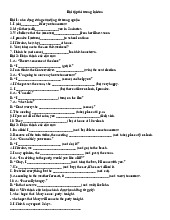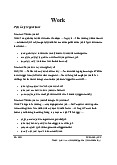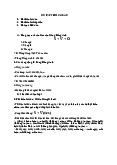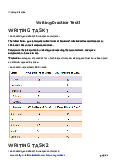



Preview text:
I. CÂU BỊ ĐỘNG LÀ GÌ?
Câu bị động là câu được dùng khi muốn nhấn mạnh đến đối tượng chịu tác động của hành
động hơn là hành động đó. Theo mỗi thì sử dụng thì cấu trúc của câu bị động cũng thay đổi theo.
1. Cấu trúc câu bị động:
Example: They built this house in 1998 (Thì quá khứ) S V O
=> This house was built in 1998 (by them) S be(was/were) + Ved/3)
Chúng ta có cấu trúc câu chủ động là: S + V + O S + be + V3/ed + (by O)
Cấu trúc câu bị động ở dạng thì nào thì chia tobe theo thì đó mà các bạn cùng tìm hiểu dưới đây.
Tuy nhiên, bạn cần lưu ý 2 điểm sau:
1. Nếu S - chủ ngữ trong câu chủ động là: they, people, everyone, someone, anyone, etc
=> thì không cần đưa vào câu bị động
V椃Ā d甃⌀: They stole my motorbike last night. (Bọn chúng lấy trộm xe máy của tôi đêm qua)
➤ My motorbike was stolen last night. (Xe máy của tôi đã bị lấy trộm đêm qua.)
2. Nếu là người hoặc vật
➤ Trực tiếp gây ra hành động thì dùng chuyển sang bị động sẽ dùng 'by'
E.g: She is making a cake => A cake is being made by her.
I. CÂU BỊ ĐỘNG TRONG CÁC THÌ
1. Câu bị động thì hiện tại Thì Chủ động Bị động Hiện tại đơn S + V + O S + be + V3 (+ by Sb/ O) My mother often washes dishes. (be: am/is/are) Dishes are often washed by my mother.
S + am/ is/ are + being + V3 (+ by S + am/ is/ are + Ving + O Hiện tại tiếp diễn Sb/ O) She is making a cake.
A cake is being made by her.
S + have/ has + been + V3 (+ by Hiện tại hoàn S + have/ has + V3 + O Sb/ O) thành
He has washed his car for hours.
His car has been washed by him for hours.
2. Câu bị động thì quá khứ Thì Chủ động Bị động S + V-ed + O
S + was/ were + V3 (+ by Sb/ O) Quá khứ đơn My mother bought that washing
That washing machine was bought machine in 2010. by my mother in 2010.
S + was/ were + being + V3 (+ by S + was/ were + Ving + O Sb/ O) Quá khứ tiếp diễn
Yesterday morning she was cutting The grass was being cut by her the grass. yesterday morning. S + had + V3 + O
S + had + been + V3 (+ by Sb/ O)
Quá khứ hoàn thành She had cooked lunch before Lunch had been cooked by her leaving. before she left.
3. Câu bị động thì tương lai Thì Chủ động Bị động S + will V + O S + will be + V3 (+ by Sb/ O) Tương lai đơn I will feed the dogs. The dogs will be fed.
S + will have + been + V3 (+ by Sb/ S + will have + V3 + O O)
Tương lai hoàn thành They will have completed the The assignment will have been
assignment by the end of January. completed by the end of January.
4. Câu bị động sử dụng động từ khuyết thiếu(may, should, can, might, ougth to, must, …..)
Riêng với động từ khuyết thiếu, công thức của câu bị động có sự khác biệt một chút:
S + modal verb + be + V3 (+ by O) Ví dụ:
This must be done before Christmas. Dạng đặc biệt: Need + Ving = Need to be + V3 III. Luyện tập
Exercise 1: Chuyển các câu sau sang thể bị động. 1. The waiter brings me this dish.
=> I am brought this dish by the waiter.
=> This dish is brought with me by the waiter.
2. Our friends send these postcards to us. S V O
=> These postcards are sent to us by our friends.
3. Their grandmother told them this story when they visited her last week.
=> They were told this story by their grandmother when ……………………
4. Tim ordered this train ticket for his mother.
=> This train ticket was ordered for his mother by Tim.
5. She showed her ticket to the airline agent.
=> Her ticket was showed to the airline agent by her.
6. Jim baked this cake yesterday.
=> This cake was baked by Jim yesterday.
8. The shop assistant handed these boxes to the customer.
9. The board awarded the first prize to the reporter.
10. Have you sent the Christmas cards to your family?
11. The committee appointed Alice secretary for the meeting.
12. Tom will give Anna a ride to school tomorrow.
=> Anna will be given a ride to school by Tom tomorrow.
13. They keep this room tidy all the time.
=> this room is kept tidy all the time.
14. We gave Ann some bananas and some flowers.
=> Ann was given some bananas and some flowers.
15. They moved the fridge into the living room.
=> The fridge was moved into the living room.
Exercise 2: Chuyển các câu hỏi sau sang thể bị động. 1. When will you do the work?
2. How are you going to deal with this problem?
3. How do you spend this amount of money?
4. I wonder whether the board of directors will choose Susan or Jane for the position.
5. How did the police find the lost man?




